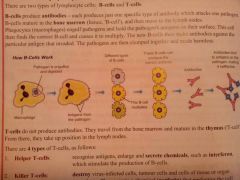![]()
![]()
![]()
Use LEFT and RIGHT arrow keys to navigate between flashcards;
Use UP and DOWN arrow keys to flip the card;
H to show hint;
A reads text to speech;
42 Cards in this Set
- Front
- Back
|
What are the two lines of defence that the body has?, |
1. General Defence System (Natural Immunity) 2. Specific Defence System (Induced Immunity) |
|
|
What is the General defence system required to do? |
To be prepared to deal with any pathogens before they enter the body |
|
|
Name the 4 components of the general defence system |
1. Skin 2. Mucus 3. Cilia 4. Phagocytic white blood cells |
|
|
How does the skin prevent pathogens from entering the body? |
1. Physical barrier 2. Secretes bacteriocides from sweat glands which kill bacteria |
|
|
Where is mucus produced? |
Lining of the respiratory, digestive and reproductive tracts |
|
|
How does mucus protect us from pathogens? |
Traps germs Stomach acid (HCl) kills germs |
|
|
What does cilia do to protect us from pathogens? |
Wafts mucus with trapped germs out of the body |
|
|
How do phagocytic white blood cells protect us from pathogens? |
Some engulf microbes Others secrete chemicals which stimulate fever to destroy microbes at high temperatures |
|
|
What is meant by induced immunity? |
The protection gained by the detection of antigens and the production of specific antibodies that neutralise the antigen-bearing structure |
|
|
What are antigens? |
Chemicals produced by bacteria, viruses and cancer cells. Stimulate certain lymphocytes to make antibodies |
|
|
Where would you find antibodies in the body? |
Dissolved in the blood |
|
|
Antibodies are _________ to one type of antigen |
Specific |
|
|
What do monocytes do? |
Engulf the neutralised microbe |
|
|
Name the 4 organs of the immune system |
Bone marrow Lymph nodes Spleen Thymus |
|
|
What is made in red bone marrow |
Lymphocytes and monocytes |
|
|
What is the function of the lymph nodes? |
Store large numbers of lymphocytes and allow them to mature |
|
|
What is the function of the spleen |
Stores lymphocytes |
|
|
Where is the spleen situated? |
Behind the stomach |
|
|
Where is the thymus situated ? |
Behind the breastbone |
|
|
What is the function of the thymus ? |
Allows lymphocytes to mature and become active |
|
|
What is meant by immunisation? |
The artificial way of making us immune to a disease before we come in contact with it |
|
|
What are the two ways of inducing immunity ? |
Active immunity Passive immunity |
|
|
How do vaccinations work? |
The pathogen microbe is killed using heat and then injected into the person. It cannot harm the person but the antigens on its surface stimulated the production of the specific antibodies against it. The antibodies are now present to deal with the real germ should it invade the body. |
|
|
Is active immunity short or long lived? |
Long lived |
|
|
What is passive immunity? |
Giving ready-made antibodies to the person |
|
|
Give an example of passive immunity |
The child receiving antibodies from the mother through the placenta |
|
|
Is passive immunity long or short lived? |
Short lived |
|
|
what are the two types of lymphocytes? |
B-cells and T-cells |
|
|
What so B-cells produce? |
Antibodies |
|
|
Where do B-cells mature? |
Bone marrow |
|
|
What so phagocytes do? |
Engulf the pathogen and hold the antigen on its surface |
|
|
Give the name of the type of phagocyte which does this? |
Macrophage |
|
|
What does this macrophage with the antigen do then? |
Finds the correct B-cell and causes it to multiply |
|
|
What do the new B-cells do then? |
Make antibodies against the particular antigen |
|
|
What happens to the pathogens after the antibodies have tackled them? |
Clump together and made harmless |
|
|
How B-Cells work |

|
|
|
Where do T-Cells mature? |
Thymus |
|
|
What are the 4 types of T cells? |
1. Helper T-cells 2. Killer T-cells 3. Suppressor T-cells 4. Memory T-cells |
|
|
Give the function of the helper T-cells |
Recognise antigen, enlarge and secrete chemicals (interferon) which stimulate the production of B-cells |
|
|
What it the function of Killer T-Cells? |
Destroy virus-infected cells, tumour cells and transplant cells. Secrete perforin that perforates cell membranes |
|
|
What is the function of suppressor T-cells ? |
Inhibits B-cell, other T-cells and monocyte production. Stop immune response after the pathogen has been destroyed |
|
|
What is the function of memory T-cells? |
Memorise the specific immune response If pathogen invades again, an immediate production of the correct antibody occurs |

